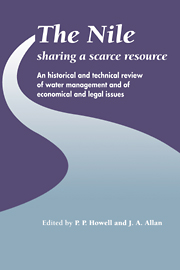 The Nile: Sharing a Scarce Resource
The Nile: Sharing a Scarce Resource Book contents
- Frontmatter
- Contents
- Preface
- List of Contributors
- Orthography
- Units and Conversion Factors
- Introduction
- I Environmental history of the Nile and its management
- II Nile management and factors affecting future management
- III Future utilisation of Nile waters
- IV Economic, international and legal issues
- 14 Evolving water demands and national development options
- 15 The Nile Basin: water management strategies
- 16 History of the Nile Basin and Lake Victoria basins through treaties
- 17 Principles and precedents in international law governing the sharing of Nile waters
- 18 Law and the River Nile: emerging international rules and the Sharia'h
- 19 Developing policies for harmonised Nile Waters development and management
- Index
19 - Developing policies for harmonised Nile Waters development and management
Published online by Cambridge University Press: 05 February 2012
- Frontmatter
- Contents
- Preface
- List of Contributors
- Orthography
- Units and Conversion Factors
- Introduction
- I Environmental history of the Nile and its management
- II Nile management and factors affecting future management
- III Future utilisation of Nile waters
- IV Economic, international and legal issues
- 14 Evolving water demands and national development options
- 15 The Nile Basin: water management strategies
- 16 History of the Nile Basin and Lake Victoria basins through treaties
- 17 Principles and precedents in international law governing the sharing of Nile waters
- 18 Law and the River Nile: emerging international rules and the Sharia'h
- 19 Developing policies for harmonised Nile Waters development and management
- Index
Summary
Nile Basin water allocation and management
The review of the status of the Nile resource, of the planning options of the major users and of economic, political and legal issues associated with the allocation and use of Nile water in the preceding chapters has shown that environmental and development factors have begun to interact in various parts of the Basin which have environmental, economic and political outcomes which require careful management.
The geography of Nile water has been shown to be significant in that the location of individual sites within the Basin and of individual political units determine whether the sites or countries have a potential to be water exporting or water importing. In the past when technologies for controlling water were not very effective, the advantage lay with the downstream riparians. The advantage of the downstream location was enhanced by the terrain of the lower Nile valley which is flat, slows down the flow of the river and has the capacity to accumulate the eroded silt from Ethiopia. Until the second half of the twentieth century the lower Nile countries therefore had sufficient land, sufficient water and the necessary institutions to develop Nile waters to support enduring rural and urban livelihoods.
By the second half of the twentieth century the development context had begun to change. The environmental advantage still appeared to lie with the downstream countries but the major user of water, Egypt, began to find that the volume of water available was no longer adequate for its sectoral needs.
- Type
- Chapter
- Information
- The Nile: Sharing a Scarce ResourceA Historical and Technical Review of Water Management and of Economical and Legal Issues, pp. 385 - 392Publisher: Cambridge University PressPrint publication year: 1994
- 1
- Cited by
